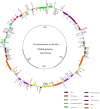Complete plastid genome sequencing of Trochodendraceae reveals a significant expansion of the inverted repeat and suggests a Paleogene divergence between the two extant species
- PMID: 23577110
- PMCID: PMC3618518
- DOI: 10.1371/journal.pone.0060429
Complete plastid genome sequencing of Trochodendraceae reveals a significant expansion of the inverted repeat and suggests a Paleogene divergence between the two extant species
Abstract
The early-diverging eudicot order Trochodendrales contains only two monospecific genera, Tetracentron and Trochodendron. Although an extensive fossil record indicates that the clade is perhaps 100 million years old and was widespread throughout the Northern Hemisphere during the Paleogene and Neogene, the two extant genera are both narrowly distributed in eastern Asia. Recent phylogenetic analyses strongly support a clade of Trochodendrales, Buxales, and Gunneridae (core eudicots), but complete plastome analyses do not resolve the relationships among these groups with strong support. However, plastid phylogenomic analyses have not included data for Tetracentron. To better resolve basal eudicot relationships and to clarify when the two extant genera of Trochodendrales diverged, we sequenced the complete plastid genome of Tetracentron sinense using Illumina technology. The Tetracentron and Trochodendron plastomes possess the typical gene content and arrangement that characterize most angiosperm plastid genomes, but both genomes have the same unusual ∼4 kb expansion of the inverted repeat region to include five genes (rpl22, rps3, rpl16, rpl14, and rps8) that are normally found in the large single-copy region. Maximum likelihood analyses of an 83-gene, 88 taxon angiosperm data set yield an identical tree topology as previous plastid-based trees, and moderately support the sister relationship between Buxaceae and Gunneridae. Molecular dating analyses suggest that Tetracentron and Trochodendron diverged between 44-30 million years ago, which is congruent with the fossil record of Trochodendrales and with previous estimates of the divergence time of these two taxa. We also characterize 154 simple sequence repeat loci from the Tetracentron sinense and Trochodendron aralioides plastomes that will be useful in future studies of population genetic structure for these relict species, both of which are of conservation concern.
Conflict of interest statement
Figures






Similar articles
-
Phylogenomic and structural analyses of 18 complete plastomes across nearly all families of early-diverging eudicots, including an angiosperm-wide analysis of IR gene content evolution.Mol Phylogenet Evol. 2016 Mar;96:93-101. doi: 10.1016/j.ympev.2015.12.006. Epub 2015 Dec 24. Mol Phylogenet Evol. 2016. PMID: 26724406
-
Trochodendron aralioides, the first chromosome-level draft genome in Trochodendrales and a valuable resource for basal eudicot research.Gigascience. 2019 Nov 1;8(11):giz136. doi: 10.1093/gigascience/giz136. Gigascience. 2019. PMID: 31738437 Free PMC article.
-
A chromosome-level genome assembly for the tertiary relict plant Tetracentron sinense oliv. (trochodendraceae).Mol Ecol Resour. 2021 May;21(4):1186-1199. doi: 10.1111/1755-0998.13334. Epub 2021 Feb 8. Mol Ecol Resour. 2021. PMID: 33486895
-
Nuclear phylogenomics of angiosperms and insights into their relationships and evolution.J Integr Plant Biol. 2024 Mar;66(3):546-578. doi: 10.1111/jipb.13609. Epub 2024 Jan 30. J Integr Plant Biol. 2024. PMID: 38289011 Review.
-
From chloroplasts to "cryptic" plastids: evolution of plastid genomes in parasitic plants.Curr Genet. 2008 Sep;54(3):111-21. doi: 10.1007/s00294-008-0208-8. Epub 2008 Aug 12. Curr Genet. 2008. PMID: 18696071 Review.
Cited by
-
Plastome Evolution in Dolomiaea (Asteraceae, Cardueae) Using Phylogenomic and Comparative Analyses.Front Plant Sci. 2020 Apr 15;11:376. doi: 10.3389/fpls.2020.00376. eCollection 2020. Front Plant Sci. 2020. PMID: 32351518 Free PMC article.
-
Phylogenetic analysis of the Critically Endangered Aquilaria khasiana (Thymelaeaceae) using barcode markers and chloroplast genome, with updated conservation status.Sci Rep. 2025 Jul 1;15(1):21511. doi: 10.1038/s41598-025-08606-x. Sci Rep. 2025. PMID: 40594782 Free PMC article.
-
Characterization of the complete chloroplast genomes of two Pachysandra species in the family Buxaceae.Mitochondrial DNA B Resour. 2025 Aug 11;10(9):816-820. doi: 10.1080/23802359.2025.2545510. eCollection 2025. Mitochondrial DNA B Resour. 2025. PMID: 40810114 Free PMC article.
-
Plastome structure, phylogenomic analyses and molecular dating of Arecaceae.Front Plant Sci. 2022 Sep 27;13:960588. doi: 10.3389/fpls.2022.960588. eCollection 2022. Front Plant Sci. 2022. PMID: 36237503 Free PMC article.
-
Taxonomy, comparative genomics of Mullein (Verbascum, Scrophulariaceae), with implications for the evolution of Verbascum and Lamiales.BMC Genomics. 2022 Aug 8;23(1):566. doi: 10.1186/s12864-022-08799-9. BMC Genomics. 2022. PMID: 35941527 Free PMC article.
References
-
- Angiosperm Phylogeny Group (2009) An update of the Angiosperm Phylogeny Group classification for the orders and families of flowering plants: APG III. Bot J Linn Soc 161: 105–121.
-
- Smith AC (1945) A taxonomic review of Trochodendron and Tetracentron . J Arnold Arbor Harvard University 26: 123–142.
-
- Cronquist A (1981) An Integrated System of Classification of Flowering Plants. New York: Columbia University Press.
-
- Endress PK (1986) Reproductive structures and phylogenetic significance of extant primitive angiosperms. Plant Syst Evol 152: 1–28.
-
- Endress PK, Igersheim A (1999) Gynoecium diversity and systematics of the basal eudicots. Bot J Linn Soc 130: 305–393.
Publication types
MeSH terms
LinkOut - more resources
Full Text Sources
Other Literature Sources
Molecular Biology Databases
Miscellaneous

